Milking 460 cows and managing a large free-range poultry enterprise alongside an anaerobic digestion (AD) plant, the McDonnell family is not short of work.
The family team consists of brothers Richard and David, alongside their father Michael. Richard manages the dairy and poultry enterprises, while David manages the AD plant alongside his business, Anuland. Anuland is a precision farming solutions company that provides technology-based grass management solutions via sensors, artificial intelligence and camera systems.
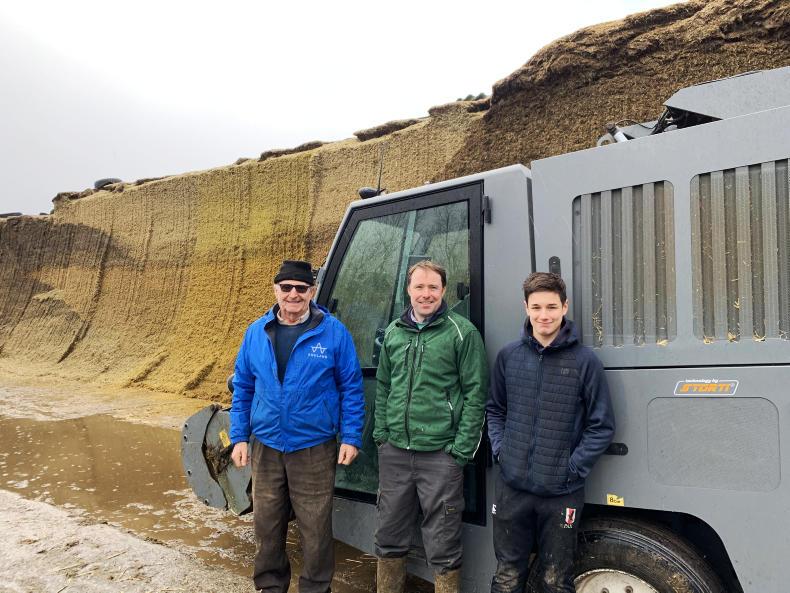
Three generations of McDonnell's; Michael, Richard and his son Geoffrey.
In 2018, Richard found himself in the market for a new diet feeder, as his Keenan Klassik 200 approached its 16th year on the farm. It was bought new in 2002.
The previous September, Richard and his father had been at the National Ploughing Championships where they first laid their eyes on the Keenan MechFiber345SP, which was in the Innovation Arena having been launched earlier that year. Richard’s father took an instant liking to the machine and the general concept of a self-propelled diet feeder.
After making initial enquires with Keenan following the Ploughing, Richard began looking into self-propelled feeder market more. A demonstration of the MechFiber345SP was done on the farm. Richard was impressed with its ease of use and performance around the farmyard.
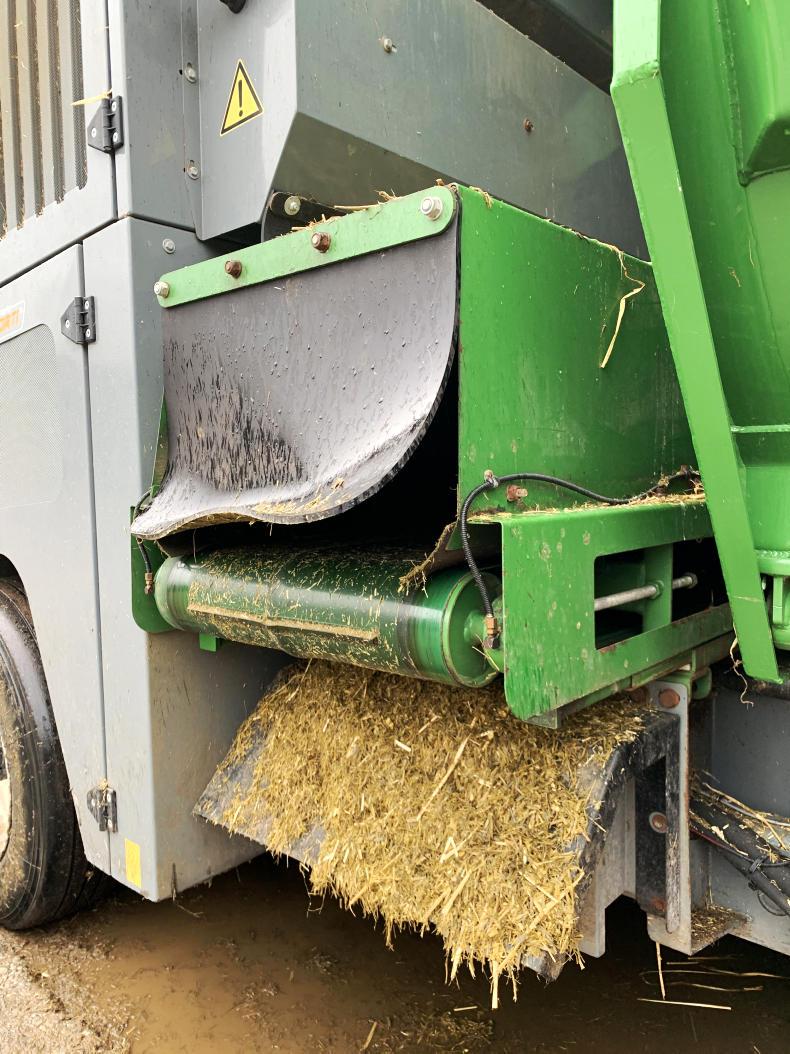
Feed can be discharged from either side of the machine, although Richard tends to use the left hand side, as its more visible from the cab.
With the old Klassik feeder working away, Richard attended EuroTier show in Hannover, Germany the following year. He knew he would see multiple self-propelled diet feeders and be able to compare and contrast each to the Keenan. Richard noted that a number of features stood out on the Keenan that some other brands didn’t have, one being the two individual foot pedals for forward and reverse instead of a left-hand shuttle.
After analysing the costs, opting for the self-propelled machine would make the most sense in the long run.
Richard explained: “Straight away I was only going to be running one engine instead of two if I bought another trailed feeder, the tractor and telehandler. The telehandler was going to need to be changed in the near future if I was to continue on with a trailed feeder.”
So Richard opted for the MechFiber345SP having taken everything into account. This included costs and the “if it’s not broke don’t fix it” approach, considering the service provided by Keenan and his older Klassik 200 feeder over the years.
Engine and transmission
Powering the MechFiber345SP is a four-cylinder, 4.5l 170hp Iveco FPT engine, meeting stage IV emission standards. Although the there are two tub sizes available – 16m3 and 20m3 – both models are fitted with the same engine. Richard noted that during a typical week the feeder takes two fills of diesel.
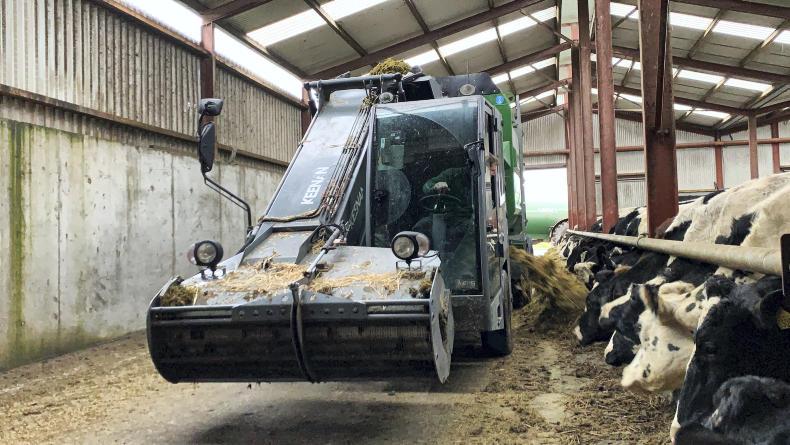
Richard feeds five loads on average daily carrying 6.5t in each.
“A typical week generally consists of five loads daily at roughly 25 to 30 minutes per load from when loading starts to unloading finishes.”
Richard believes that this alone is a major saving across a full feeding season, burning at least one-third less diesel than he was previously, running a tractor and telehandler.
The MechFiber345SP is fitted with a dual speed hydrostatic transmission. The transmission has a maximum forward speed of 25km/h, suiting Richard as the majority of feeding takes place in the main yard, with a short distance to travel up the road to the outfarm.
Power transmission to the feeder is via a mechanical drive developed by Storti. This being a straightforward mechanical driveline means its PTO shafts need to be greased routinely.
Richard noted that the shafts receive a thorough greasing every two weeks, even though it means dedicating 20 minutes to getting in under the machine and greasing each joint. From a service perspective, the essential areas are easily accessed either through the panel under the loading arm or via the panels located behind the cab.
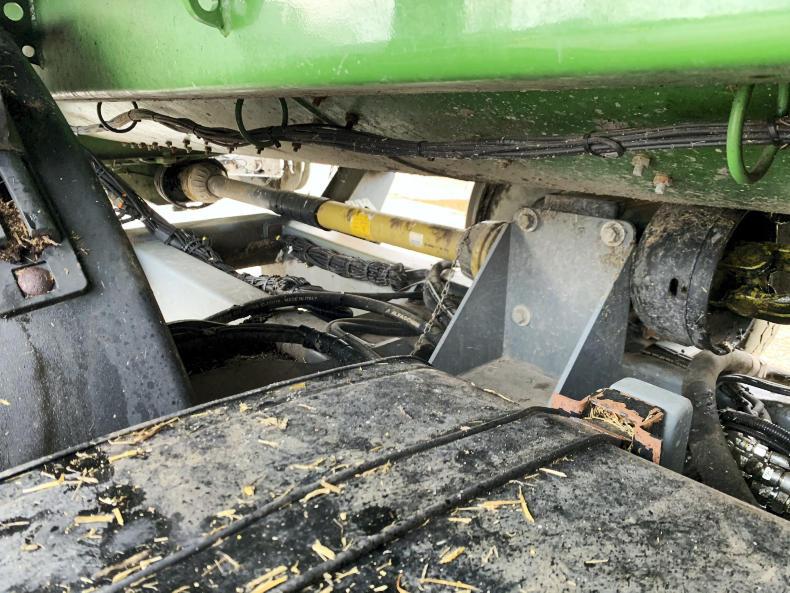
Richard greases the feeders mechanical drive shafts every two weeks.
Cab and manoeuvrability
The MechFiber345SP adopts the Storti cab. Richard complimented the clean and straightforward layout. All essential switches are either on the joystick or alongside it, he explained, while a small screen displays machine information such as fuel level, temperature and loading functions. Foot pedals inside the cab are straightforward. There is a brake pedal to the left of the steering column and forward and reverse pedals located on the right hand side. The feeder is fitted as standard with a reversible fan for removing debris from the engine’s cooling pack.
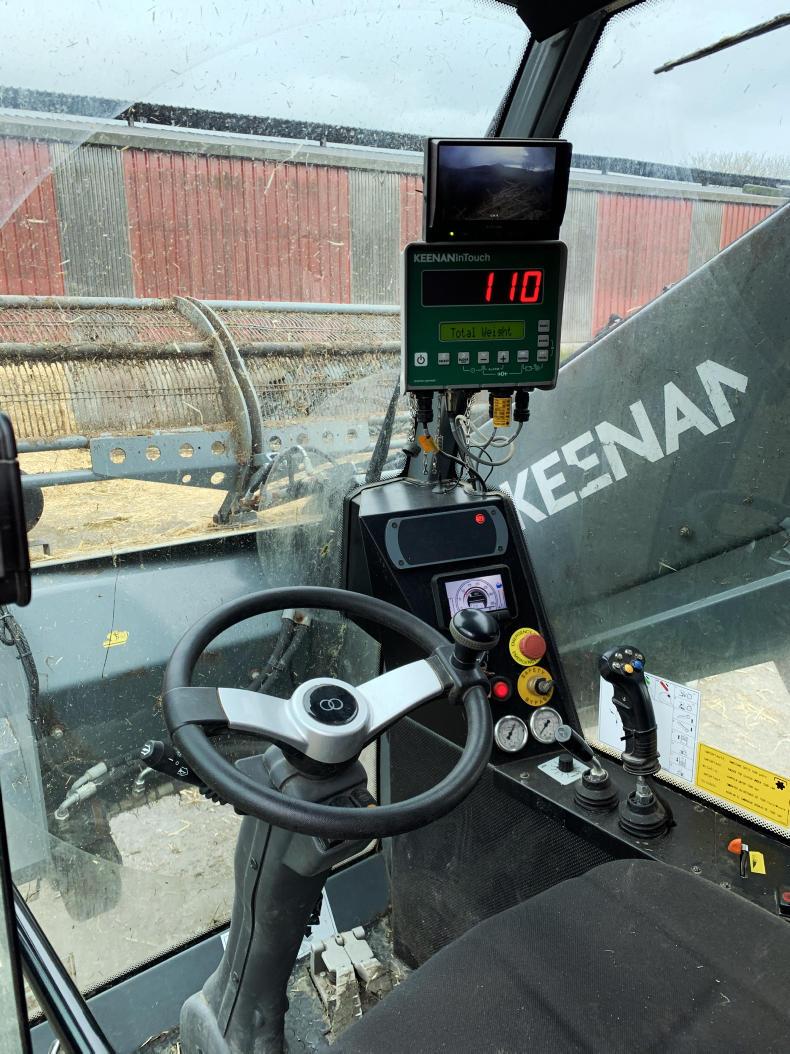
Controls inside the cab are accessible and straight forward, although the A-frame mounting of the camera monitor and InTouch panel slightly restricts visibility,
The InTouch controller is located at eye level on the A-pillar along with the monitor for the two cameras on the machine, one of which views the inside of the feeder and the other monitors the machine’s rear. Richard noted how these monitors can hinder visibility out towards the cutter head at times.
Visibility is good from the driver’s seat, especially while loading. Unloading just wouldn’t be the same naturally as Richard noted he tends to glance behind or have the side window open while unloading. The cameras are a good addition given the length of the machine and the ability to see what’s happing in the feeder.
Feed intake and mixing
The MechFiber345SP adopts the Storti cutter head and loading arm. This 2m cutting head can reach a height of 5.2m at full reach, which Richard uses to its limit given the nature of his large silage pit.
A Bosch Rexroth hydraulic motor powers the stainless steel drum which is fitted with 84 tungsten-coated blades, 42 of which are straight and the remaining 42 curved. Richard explained that blades only need to be sharpened at the start of every feeding season if no foreign objects are encountered along the way.

The stainless steel cutter head is fitted with 84 tungsten-coated blades in a crossed arrangement.
A lump of concrete managed to make its way into the silage pit, which the feeder later lifted. Apart from a few damaged blades, the machine was otherwise fine. This impressed Richard, proving the overall robustness of the feeder.
Lifting longer material such as straw, the head spins back towards the feeder so that material moves over the drum to prevent longer fibres getting jammed underneath.
All control of the loading arm is done through the joystick, giving Richard full control over the speed and height at which he starts removing feed from the pit face.
The head can even lift concentrates off the ground cleanly if required. The only issue Richard found was that on a windy day when loading straw a certain amount will blow out of the feeder.
Keenan has since rectified this on new machines with a deflector fitted to direct straw and lighter material into the feeder, not allowing wind to catch it.
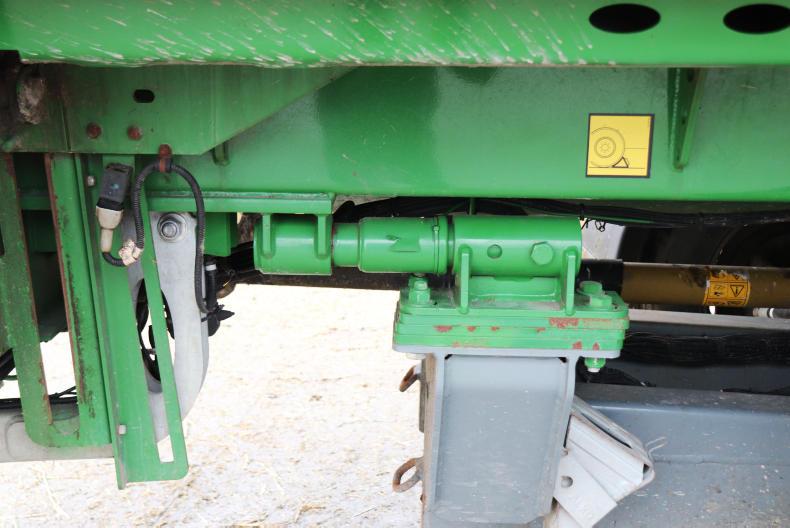
The feeder is seated on four weigh cells that communicate with the InTouch panel, providing live weights of what's inside.
The Keenan six-paddle MechFiber feeder comes standard mounted on four weigh cells, which along with the InTouch system provides Richard with the exact weights inside the feeder. As with all Keenan paddle feeders, knives are mounted to the feeder’s base, similar to what he was familiar with beforehand.
Unlike a trailed feeder, the front of the MechFiber feeder on the self-propelled machine is the rear of a trailed unit. This is done so that the driveline can be easily accessed from the rear via two large doors. Behind the doors is the main drive sprocket and chain which is oil-immersed for a long working life. A central greasing point makes greasing easy, Richard pointed out.
The steady intake of silage and other feedstuffs is key to a faster more consistent mix compared to dumping in bucketloads with the telehandler, Richard said. An autogreaser is fitted to ease lubrication of the loader arm and conveyor system.
Pit and waste management
Before taking delivery of the MechFiber345SP, waste proved to be an issue that really only became apparent a short while into the ownership of the new machine. This resulted from the way in which the silage was removed from the pit face. The way the cutter head essentially shaves the pit face has reduced wastage by between 70% and 80%, according to Richard. The clean cut pit face reduces the amount of air from entering the silage, reducing secondary fermentation.
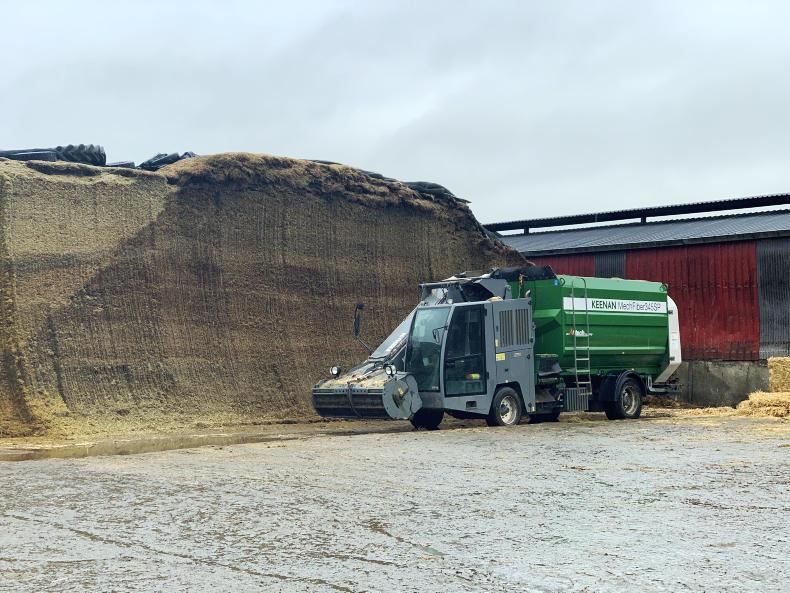
Management of the pitface with the MechFiber345SP is second to none.
Feeding passages have not been cleaned out in three months and still show little signs of wastage compared to dumper loads previous. This in particular has been a standout feature of the machine for Richard.
“Even passing by the pit face now you’d take pleasure in looking at the way in which the MechFiber345SP is able to manage it. This alone is a huge saving over the year that I never considered to be as substantial when looking into the machine first,” he explained.
Verdict
Richard took delivery of the Keenan self-propelled feeder in October 2018. Since then he has clocked up in excess of 1,000 hours.
Estimating that he will clock up in the region of 900 hours annually, hopes to keep it for roughly 10 years.
I can say for sure that I will never return to a trailed system having owned this machine
“After spending just over 14 months using the machine, I certainly don’t look back on the decision to buy it. Right from the ease of use and training staff on the feeder to the comfort and safety of not jumping from a telehandler to a tractor before mentioning the savings. I can say for sure that I will never return to a trailed system having owned this machine.”
Model: MechFiber345SP.Capacity: 16m3.Cutter head: 2m wide.Feed outlets: Two.Engine power: 170hp Iveco 4.5l four-cylinder.Length and width: 9.64m x 2.56m.Starting price: €160,000 plus VAT.Likes
Overall reduced wastage due to
better pit face management.Consistent mix due to gradual infeed of feed constituents.The fact one machine does all without the need to leave cab. Overall safety of the machine.O Dislikes
Could benefit from a rear steering axle for better manoeuvrability.A-Pillar terminals restrict visibility.Low ground clearance.Agricultural tyres would be more beneficial for grip in the yard.Keenan Self-propelled

The MechFiber345SP has a maximum reach of 4.5m.
Keenan entered the self-propelled and tub feeder market in collaboration with the well-established Italian diet feeder manufacturer Storti in 2016.
Storti at the time had both self-propelled and tub feeders on the market for some time so this strategic alliance was pretty much a matter of marrying the two companies’ offerings together to produce the MechFiber345SP.
The MechFiber345 is essentially a Storti driveline and infeed system fitted with Keenan’s MechFiber six-paddle feeder and InTouch technology. Although the number of self-propelled diet feeders across the country could be counted on one hand we were keen to see one in its working clothes.
Milking 460 cows and managing a large free-range poultry enterprise alongside an anaerobic digestion (AD) plant, the McDonnell family is not short of work.
The family team consists of brothers Richard and David, alongside their father Michael. Richard manages the dairy and poultry enterprises, while David manages the AD plant alongside his business, Anuland. Anuland is a precision farming solutions company that provides technology-based grass management solutions via sensors, artificial intelligence and camera systems.

Three generations of McDonnell's; Michael, Richard and his son Geoffrey.
In 2018, Richard found himself in the market for a new diet feeder, as his Keenan Klassik 200 approached its 16th year on the farm. It was bought new in 2002.
The previous September, Richard and his father had been at the National Ploughing Championships where they first laid their eyes on the Keenan MechFiber345SP, which was in the Innovation Arena having been launched earlier that year. Richard’s father took an instant liking to the machine and the general concept of a self-propelled diet feeder.
After making initial enquires with Keenan following the Ploughing, Richard began looking into self-propelled feeder market more. A demonstration of the MechFiber345SP was done on the farm. Richard was impressed with its ease of use and performance around the farmyard.

Feed can be discharged from either side of the machine, although Richard tends to use the left hand side, as its more visible from the cab.
With the old Klassik feeder working away, Richard attended EuroTier show in Hannover, Germany the following year. He knew he would see multiple self-propelled diet feeders and be able to compare and contrast each to the Keenan. Richard noted that a number of features stood out on the Keenan that some other brands didn’t have, one being the two individual foot pedals for forward and reverse instead of a left-hand shuttle.
After analysing the costs, opting for the self-propelled machine would make the most sense in the long run.
Richard explained: “Straight away I was only going to be running one engine instead of two if I bought another trailed feeder, the tractor and telehandler. The telehandler was going to need to be changed in the near future if I was to continue on with a trailed feeder.”
So Richard opted for the MechFiber345SP having taken everything into account. This included costs and the “if it’s not broke don’t fix it” approach, considering the service provided by Keenan and his older Klassik 200 feeder over the years.
Engine and transmission
Powering the MechFiber345SP is a four-cylinder, 4.5l 170hp Iveco FPT engine, meeting stage IV emission standards. Although the there are two tub sizes available – 16m3 and 20m3 – both models are fitted with the same engine. Richard noted that during a typical week the feeder takes two fills of diesel.

Richard feeds five loads on average daily carrying 6.5t in each.
“A typical week generally consists of five loads daily at roughly 25 to 30 minutes per load from when loading starts to unloading finishes.”
Richard believes that this alone is a major saving across a full feeding season, burning at least one-third less diesel than he was previously, running a tractor and telehandler.
The MechFiber345SP is fitted with a dual speed hydrostatic transmission. The transmission has a maximum forward speed of 25km/h, suiting Richard as the majority of feeding takes place in the main yard, with a short distance to travel up the road to the outfarm.
Power transmission to the feeder is via a mechanical drive developed by Storti. This being a straightforward mechanical driveline means its PTO shafts need to be greased routinely.
Richard noted that the shafts receive a thorough greasing every two weeks, even though it means dedicating 20 minutes to getting in under the machine and greasing each joint. From a service perspective, the essential areas are easily accessed either through the panel under the loading arm or via the panels located behind the cab.

Richard greases the feeders mechanical drive shafts every two weeks.
Cab and manoeuvrability
The MechFiber345SP adopts the Storti cab. Richard complimented the clean and straightforward layout. All essential switches are either on the joystick or alongside it, he explained, while a small screen displays machine information such as fuel level, temperature and loading functions. Foot pedals inside the cab are straightforward. There is a brake pedal to the left of the steering column and forward and reverse pedals located on the right hand side. The feeder is fitted as standard with a reversible fan for removing debris from the engine’s cooling pack.

Controls inside the cab are accessible and straight forward, although the A-frame mounting of the camera monitor and InTouch panel slightly restricts visibility,
The InTouch controller is located at eye level on the A-pillar along with the monitor for the two cameras on the machine, one of which views the inside of the feeder and the other monitors the machine’s rear. Richard noted how these monitors can hinder visibility out towards the cutter head at times.
Visibility is good from the driver’s seat, especially while loading. Unloading just wouldn’t be the same naturally as Richard noted he tends to glance behind or have the side window open while unloading. The cameras are a good addition given the length of the machine and the ability to see what’s happing in the feeder.
Feed intake and mixing
The MechFiber345SP adopts the Storti cutter head and loading arm. This 2m cutting head can reach a height of 5.2m at full reach, which Richard uses to its limit given the nature of his large silage pit.
A Bosch Rexroth hydraulic motor powers the stainless steel drum which is fitted with 84 tungsten-coated blades, 42 of which are straight and the remaining 42 curved. Richard explained that blades only need to be sharpened at the start of every feeding season if no foreign objects are encountered along the way.

The stainless steel cutter head is fitted with 84 tungsten-coated blades in a crossed arrangement.
A lump of concrete managed to make its way into the silage pit, which the feeder later lifted. Apart from a few damaged blades, the machine was otherwise fine. This impressed Richard, proving the overall robustness of the feeder.
Lifting longer material such as straw, the head spins back towards the feeder so that material moves over the drum to prevent longer fibres getting jammed underneath.
All control of the loading arm is done through the joystick, giving Richard full control over the speed and height at which he starts removing feed from the pit face.
The head can even lift concentrates off the ground cleanly if required. The only issue Richard found was that on a windy day when loading straw a certain amount will blow out of the feeder.
Keenan has since rectified this on new machines with a deflector fitted to direct straw and lighter material into the feeder, not allowing wind to catch it.

The feeder is seated on four weigh cells that communicate with the InTouch panel, providing live weights of what's inside.
The Keenan six-paddle MechFiber feeder comes standard mounted on four weigh cells, which along with the InTouch system provides Richard with the exact weights inside the feeder. As with all Keenan paddle feeders, knives are mounted to the feeder’s base, similar to what he was familiar with beforehand.
Unlike a trailed feeder, the front of the MechFiber feeder on the self-propelled machine is the rear of a trailed unit. This is done so that the driveline can be easily accessed from the rear via two large doors. Behind the doors is the main drive sprocket and chain which is oil-immersed for a long working life. A central greasing point makes greasing easy, Richard pointed out.
The steady intake of silage and other feedstuffs is key to a faster more consistent mix compared to dumping in bucketloads with the telehandler, Richard said. An autogreaser is fitted to ease lubrication of the loader arm and conveyor system.
Pit and waste management
Before taking delivery of the MechFiber345SP, waste proved to be an issue that really only became apparent a short while into the ownership of the new machine. This resulted from the way in which the silage was removed from the pit face. The way the cutter head essentially shaves the pit face has reduced wastage by between 70% and 80%, according to Richard. The clean cut pit face reduces the amount of air from entering the silage, reducing secondary fermentation.

Management of the pitface with the MechFiber345SP is second to none.
Feeding passages have not been cleaned out in three months and still show little signs of wastage compared to dumper loads previous. This in particular has been a standout feature of the machine for Richard.
“Even passing by the pit face now you’d take pleasure in looking at the way in which the MechFiber345SP is able to manage it. This alone is a huge saving over the year that I never considered to be as substantial when looking into the machine first,” he explained.
Verdict
Richard took delivery of the Keenan self-propelled feeder in October 2018. Since then he has clocked up in excess of 1,000 hours.
Estimating that he will clock up in the region of 900 hours annually, hopes to keep it for roughly 10 years.
I can say for sure that I will never return to a trailed system having owned this machine
“After spending just over 14 months using the machine, I certainly don’t look back on the decision to buy it. Right from the ease of use and training staff on the feeder to the comfort and safety of not jumping from a telehandler to a tractor before mentioning the savings. I can say for sure that I will never return to a trailed system having owned this machine.”
Model: MechFiber345SP.Capacity: 16m3.Cutter head: 2m wide.Feed outlets: Two.Engine power: 170hp Iveco 4.5l four-cylinder.Length and width: 9.64m x 2.56m.Starting price: €160,000 plus VAT.Likes
Overall reduced wastage due to
better pit face management.Consistent mix due to gradual infeed of feed constituents.The fact one machine does all without the need to leave cab. Overall safety of the machine.O Dislikes
Could benefit from a rear steering axle for better manoeuvrability.A-Pillar terminals restrict visibility.Low ground clearance.Agricultural tyres would be more beneficial for grip in the yard.Keenan Self-propelled

The MechFiber345SP has a maximum reach of 4.5m.
Keenan entered the self-propelled and tub feeder market in collaboration with the well-established Italian diet feeder manufacturer Storti in 2016.
Storti at the time had both self-propelled and tub feeders on the market for some time so this strategic alliance was pretty much a matter of marrying the two companies’ offerings together to produce the MechFiber345SP.
The MechFiber345 is essentially a Storti driveline and infeed system fitted with Keenan’s MechFiber six-paddle feeder and InTouch technology. Although the number of self-propelled diet feeders across the country could be counted on one hand we were keen to see one in its working clothes.















 This is a subscriber-only article
This is a subscriber-only article










SHARING OPTIONS: